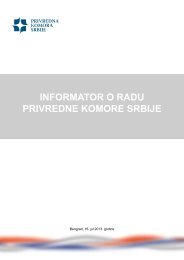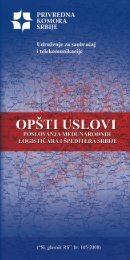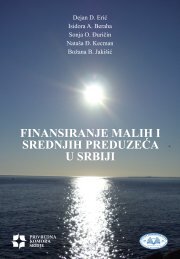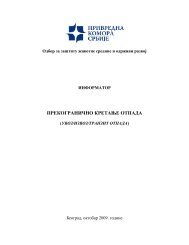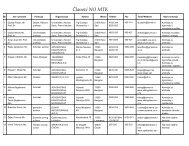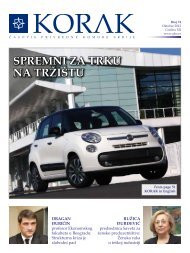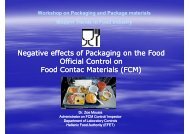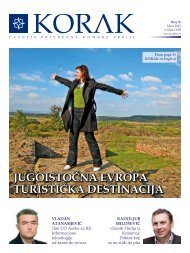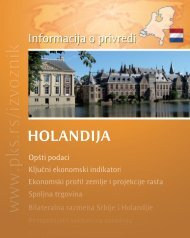- Page 1 and 2:
„ RUDARSTVO 2011“ / „ MINING
- Page 3 and 4:
ORGANIZATORI / ORGANIZERINSTITUT ZA
- Page 5 and 6:
S A D R Ţ A J / C O N T E N T S:Pl
- Page 7 and 8:
SWOT ANALIZA ENERGETSKOG POTENCIJAL
- Page 9:
‣ Ljubiša Obradović, Daniela Ur
- Page 12 and 13:
Rudarstvo 2011 / Mining 2011Cilj an
- Page 15 and 16:
Rudarstvo 2011 / Mining 2011FAZE IS
- Page 17 and 18:
Rudarstvo 2011 / Mining 2011Slika 2
- Page 19 and 20:
Rudarstvo 2011 / Mining 2011LITERAT
- Page 21 and 22:
Rudarstvo 2011 / Mining 2011Kao pos
- Page 23 and 24:
Rudarstvo 2011 / Mining 2011Do 2000
- Page 26 and 27:
Rudarstvo 2011 / Mining 2011Slika 1
- Page 28 and 29:
Rudarstvo 2011 / Mining 2011Slika 3
- Page 30 and 31:
Rudarstvo 2011 / Mining 2011Ovakvom
- Page 32 and 33:
Rudarstvo 2011 / Mining 20115. Potr
- Page 34 and 35:
Rudarstvo 2011 / Mining 2011PERSPEK
- Page 36 and 37:
Rudarstvo 2011 / Mining 2011- Ukupn
- Page 38 and 39:
Rudarstvo 2011 / Mining 20112.1. OS
- Page 40 and 41:
Rudarstvo 2011 / Mining 2011Slika 1
- Page 42 and 43:
Rudarstvo 2011 / Mining 2011Kop je
- Page 44 and 45:
Rudarstvo 2011 / Mining 2011 koliĉ
- Page 46 and 47:
Rudarstvo 2011 / Mining 2011Izgled
- Page 48 and 49:
Rudarstvo 2011 / Mining 20112.4. LE
- Page 50 and 51:
Rudarstvo 2011 / Mining 2011Slika b
- Page 52 and 53:
Rudarstvo 2011 / Mining 2011AKTUELN
- Page 54 and 55:
Rudarstvo 2011 / Mining 2011eksploa
- Page 56 and 57:
Rudarstvo 2011 / Mining 2011Soko 58
- Page 58 and 59:
Rudarstvo 2011 / Mining 20111.200.0
- Page 60 and 61:
Rudarstvo 2011 / Mining 2011Kratkor
- Page 62 and 63:
Rudarstvo 2011 / Mining 2011Slika 1
- Page 64 and 65:
Rudarstvo 2011 / Mining 2011Slika 3
- Page 66 and 67:
Rudarstvo 2011 / Mining 20112.3. Re
- Page 68 and 69:
Rudarstvo 2011 / Mining 2011Slika 7
- Page 70 and 71:
Rudarstvo 2011 / Mining 2011- pouzd
- Page 72 and 73:
Rudarstvo 2011 / Mining 2011Zaštit
- Page 74 and 75:
P LJ E V LJ ARudarstvo 2011 / Minin
- Page 76 and 77:
Rudarstvo 2011 / Mining 2011E p1 =
- Page 78 and 79:
Rudarstvo 2011 / Mining 2011Napomen
- Page 80 and 81:
Rudarstvo 2011 / Mining 2011Strateg
- Page 82 and 83:
Rudarstvo 2011 / Mining 2011projeka
- Page 84 and 85:
Rudarstvo 2011 / Mining 2011Potenci
- Page 86 and 87:
Rudarstvo 2011 / Mining 2011KINAUSA
- Page 88 and 89:
Rudarstvo 2011 / Mining 2011INDUSTR
- Page 90 and 91:
Rudarstvo 2011 / Mining 2011prikaţ
- Page 92 and 93:
Rudarstvo 2011 / Mining 2011taĉno
- Page 94 and 95:
19871001989100199110019931001995100
- Page 96 and 97:
Rudarstvo 2011 / Mining 2011tehnolo
- Page 98 and 99:
Rudarstvo 2011 / Mining 20112. AD H
- Page 100 and 101:
Rudarstvo 2011 / Mining 2011Osnovni
- Page 102 and 103:
Rudarstvo 2011 / Mining 2011Na kopu
- Page 104 and 105:
Rudarstvo 2011 / Mining 2011Šema s
- Page 106 and 107:
Rudarstvo 2011 / Mining 2011Bigar i
- Page 108 and 109:
Rudarstvo 2011 / Mining 2011AKTUELN
- Page 110 and 111:
Rudarstvo 2011 / Mining 2011Naziv s
- Page 112 and 113:
Rudarstvo 2011 / Mining 2011DunitiL
- Page 114 and 115:
Rudarstvo 2011 / Mining 2011Kopovi,
- Page 116 and 117:
Rudarstvo 2011 / Mining 2011ISirovi
- Page 118 and 119:
Rudarstvo 2011 / Mining 2011Srbije
- Page 120 and 121:
Rudarstvo 2011 / Mining 2011emissio
- Page 122 and 123:
Rudarstvo 2011 / Mining 2011zagaĊe
- Page 124 and 125:
Rudarstvo 2011 / Mining 2011Šta ur
- Page 126 and 127:
Rudarstvo 2011 / Mining 2011Ekonoms
- Page 128 and 129:
Rudarstvo 2011 / Mining 2011Kljuĉn
- Page 130 and 131:
Rudarstvo 2011 / Mining 2011[12] Mi
- Page 132 and 133:
Rudarstvo 2011 / Mining 2011Poseban
- Page 134 and 135:
Rudarstvo 2011 / Mining 2011Otkopav
- Page 136 and 137:
Rudarstvo 2011 / Mining 2011Iz poda
- Page 138 and 139:
Rudarstvo 2011 / Mining 20111.UvodR
- Page 140 and 141:
Rudarstvo 2011 / Mining 2011Slika 2
- Page 142 and 143:
Rudarstvo 2011 / Mining 2011[12 str
- Page 144 and 145:
Rudarstvo 2011 / Mining 2011u obzir
- Page 146 and 147:
Rudarstvo 2011 / Mining 2011i 3) te
- Page 148 and 149:
Rudarstvo 2011 / Mining 2011poslova
- Page 150 and 151:
Rudarstvo 2011 / Mining 2011Specifi
- Page 152 and 153:
Rudarstvo 2011 / Mining 2011moralne
- Page 154 and 155:
Rudarstvo 2011 / Mining 2011mineral
- Page 156 and 157:
Rudarstvo 2011 / Mining 2011Eksploa
- Page 158 and 159:
Rudarstvo 2011 / Mining 2011PROSTOR
- Page 160 and 161:
Rudarstvo 2011 / Mining 20111200m i
- Page 162 and 163:
Rudarstvo 2011 / Mining 2011S 1,5 1
- Page 164 and 165:
Rudarstvo 2011 / Mining 2011Slika 2
- Page 166 and 167:
Rudarstvo 2011 / Mining 2011NOVI ZA
- Page 168 and 169:
Rudarstvo 2011 / Mining 2011Sistemi
- Page 170 and 171:
Rudarstvo 2011 / Mining 2011ZAVRŠE
- Page 172 and 173:
Rudarstvo 2011 / Mining 2011SLIKE O
- Page 174 and 175:
Rudarstvo 2011 / Mining 2011• Wir
- Page 176 and 177:
Rudarstvo 2011 / Mining 2011KORIŠ
- Page 178 and 179:
Rudarstvo 2011 / Mining 2011Slika b
- Page 180 and 181:
Rudarstvo 2011 / Mining 2011DRENAŢ
- Page 182 and 183:
Rudarstvo 2011 / Mining 20115.ZAŠT
- Page 184 and 185:
Rudarstvo 2011 / Mining 2011GEOMEMB
- Page 186 and 187:
Rudarstvo 2011 / Mining 2011ZBRINJA
- Page 188 and 189:
Rudarstvo 2011 / Mining 2011uslova
- Page 190 and 191:
Rudarstvo 2011 / Mining 2011prikupl
- Page 192 and 193:
Rudarstvo 2011 / Mining 2011Sl.7 Iz
- Page 194 and 195:
Rudarstvo 2011 / Mining 2011će po
- Page 196 and 197:
Rudarstvo 2011 / Mining 20113. Sadr
- Page 198 and 199:
Rudarstvo 2011 / Mining 2011a) Da p
- Page 200 and 201:
Rudarstvo 2011 / Mining 20118. Inve
- Page 202 and 203:
Rudarstvo 2011 / Mining 2011Stepeni
- Page 204 and 205:
Rudarstvo 2011 / Mining 2011MJESTO
- Page 206 and 207:
Rudarstvo 2011 / Mining 2011III ugl
- Page 208 and 209:
Rudarstvo 2011 / Mining 20113.0.0 S
- Page 210 and 211:
Rudarstvo 2011 / Mining 20113.2.0 I
- Page 212 and 213:
Rudarstvo 2011 / Mining 2011UPOTREB
- Page 214 and 215:
Rudarstvo 2011 / Mining 2011GRANIĈ
- Page 216 and 217:
Rudarstvo 2011 / Mining 2011Slika 4
- Page 218 and 219:
Rudarstvo 2011 / Mining 2011KREIRAN
- Page 220 and 221:
Rudarstvo 2011 / Mining 2011GENEZA
- Page 222 and 223:
Rudarstvo 2011 / Mining 2011Slika b
- Page 224 and 225:
Rudarstvo 2011 / Mining 2011Slika b
- Page 226 and 227:
Rudarstvo 2011 / Mining 2011prvom r
- Page 228 and 229:
Rudarstvo 2011 / Mining 2011OTVARAN
- Page 230 and 231:
Rudarstvo 2011 / Mining 2011- najma
- Page 232 and 233:
16412411412413414415410418419420420
- Page 234 and 235:
Rudarstvo 2011 / Mining 2011Relativ
- Page 236 and 237:
Rudarstvo 2011 / Mining 2011RAZMATR
- Page 238 and 239:
Rudarstvo 2011 / Mining 2011Duţina
- Page 240 and 241:
Rudarstvo 2011 / Mining 20112.5.0 V
- Page 242 and 243:
Rudarstvo 2011 / Mining 2011U2- 1 z
- Page 244 and 245:
Rudarstvo 2011 / Mining 2011V BTO s
- Page 246 and 247:
Rudarstvo 2011 / Mining 2011enables
- Page 248 and 249:
Rudarstvo 2011 / Mining 2011Za izme
- Page 250 and 251:
Rudarstvo 2011 / Mining 2011Reka Pe
- Page 252 and 253:
Rudarstvo 2011 / Mining 2011kolubar
- Page 254 and 255:
Rudarstvo 2011 / Mining 2011Obzrom
- Page 256 and 257:
Rudarstvo 2011 / Mining 2011GEOLOŠ
- Page 258 and 259:
UGLJEVIČKA UGLJONOSNA FORMACIJARud
- Page 260 and 261:
222.06206.51205.96224. 81 211. 5215
- Page 262 and 263:
Rudarstvo 2011 / Mining 2011HIDRODI
- Page 264 and 265:
Rudarstvo 2011 / Mining 2011Slika 2
- Page 266 and 267:
Rudarstvo 2011 / Mining 2011Slika 5
- Page 268 and 269:
Rudarstvo 2011 / Mining 2011Slika 7
- Page 270 and 271:
Rudarstvo 2011 / Mining 2011Slika 8
- Page 272 and 273:
Rudarstvo 2011 / Mining 2011Rezulta
- Page 274 and 275:
Rudarstvo 2011 / Mining 2011Slika 1
- Page 276 and 277:
Rudarstvo 2011 / Mining 2011Slika 1
- Page 278 and 279:
Rudarstvo 2011 / Mining 2011sl. br.
- Page 280 and 281:
Rudarstvo 2011 / Mining 2011blok na
- Page 282 and 283:
Rudarstvo 2011 / Mining 2011Zaklju
- Page 284 and 285:
Rudarstvo 2011 / Mining 2011zapadu
- Page 286 and 287:
Rudarstvo 2011 / Mining 2011- Zatva
- Page 288 and 289:
Rudarstvo 2011 / Mining 2011Tabela
- Page 290 and 291:
Rudarstvo 2011 / Mining 2011Proraĉ
- Page 292 and 293:
Rudarstvo 2011 / Mining 2011primjen
- Page 294 and 295:
Rudarstvo 2011 / Mining 2011- Mogu
- Page 296 and 297:
Rudarstvo 2011 / Mining 2011β 2 Z
- Page 298 and 299:
Rudarstvo 2011 / Mining 2011Izvod:P
- Page 300 and 301:
Rudarstvo 2011 / Mining 20113. Tret
- Page 302 and 303:
Rudarstvo 2011 / Mining 2011potpuno
- Page 304 and 305:
Rudarstvo 2011 / Mining 2011Primena
- Page 306 and 307:
Rudarstvo 2011 / Mining 2011Istraţ
- Page 308 and 309:
Rudarstvo 2011 / Mining 2011prilago
- Page 310 and 311:
Rudarstvo 2011 / Mining 2011Modul z
- Page 312 and 313:
Kamenolom ''Nepri~ava''(kre~njak)Ka
- Page 314 and 315:
Rudarstvo 2011 / Mining 2011površi
- Page 316 and 317:
Rudarstvo 2011 / Mining 2011Odvodnj
- Page 318 and 319:
Rudarstvo 2011 / Mining 20113.0 RED
- Page 320 and 321:
Rudarstvo 2011 / Mining 2011(sistem
- Page 322 and 323:
Rudarstvo 2011 / Mining 2011TATRA N
- Page 324 and 325:
Rudarstvo 2011 / Mining 2011Znajuć
- Page 326 and 327:
Rudarstvo 2011 / Mining 20112.894.5
- Page 328 and 329:
Rudarstvo 2011 / Mining 2011Slika 1
- Page 330 and 331:
SU8SchRs630Rudarstvo 2011 / Mining
- Page 332 and 333:
Rudarstvo 2011 / Mining 2011odabran
- Page 334 and 335:
Rudarstvo 2011 / Mining 2011SWOT AN
- Page 336 and 337:
Rudarstvo 2011 / Mining 2011Slika 1
- Page 338 and 339:
Rudarstvo 2011 / Mining 2011POTENCI
- Page 340 and 341:
GEOLOŠKIREGIONALNIRudarstvo 2011 /
- Page 342 and 343:
REGIONALNIEKONOMSKO-RAZVOJNIPRAVNIR
- Page 344 and 345:
PRAVNISOCIJALNIEKOLOŠKIRudarstvo 2
- Page 346 and 347:
Rudarstvo 2011 / Mining 20114. Simi
- Page 348 and 349:
Rudarstvo 2011 / Mining 2011Junkovc
- Page 350 and 351:
Rudarstvo 2011 / Mining 2011Prethod
- Page 352 and 353:
Rudarstvo 2011 / Mining 2011Izabran
- Page 354 and 355:
Rudarstvo 2011 / Mining 2011U odnos
- Page 356 and 357:
Rudarstvo 2011 / Mining 2011otkopni
- Page 358 and 359:
Rudarstvo 2011 / Mining 2011Kapacit
- Page 360 and 361:
GodinaVrijeme rada(h)tehnološkizas
- Page 362 and 363:
Rudarstvo 2011 / Mining 2011PRIMJEN
- Page 364 and 365:
Rudarstvo 2011 / Mining 2011toplotn
- Page 366 and 367:
Rudarstvo 2011 / Mining 2011Izbor t
- Page 368 and 369:
Rudarstvo 2011 / Mining 2011bagera
- Page 370 and 371:
Kapacitet (čm3/h)Rudarstvo 2011 /
- Page 372 and 373:
Rudarstvo 2011 / Mining 2011H 9 C 4
- Page 374 and 375:
Rudarstvo 2011 / Mining 2011123000
- Page 376 and 377:
Iskorišćenje Cu; (%)Rudarstvo 201
- Page 378 and 379:
Rudarstvo 2011 / Mining 2011PRODUŢ
- Page 380 and 381:
Rudarstvo 2011 / Mining 2011Slika 2
- Page 382 and 383:
Rudarstvo 2011 / Mining 2011Tabela
- Page 384 and 385:
Rudarstvo 2011 / Mining 20114. DEMO
- Page 386 and 387:
Rudarstvo 2011 / Mining 2011Teţiš
- Page 388 and 389:
Rudarstvo 2011 / Mining 2011granula
- Page 390 and 391:
Rudarstvo 2011 / Mining 2011Na osno
- Page 392 and 393:
Rudarstvo 2011 / Mining 2011Izbor p
- Page 394 and 395:
Rudarstvo 2011 / Mining 2011STABILN
- Page 396 and 397:
Rudarstvo 2011 / Mining 2011X-ray a
- Page 398 and 399:
Ostatak RRudarstvo 2011 / Mining 20
- Page 400 and 401:
Rudarstvo 2011 / Mining 2011Mlevenj
- Page 402 and 403:
Iskorišćenje Cu (%)t=20min-75μm9
- Page 404 and 405: Rudarstvo 2011 / Mining 2011SISTEMI
- Page 406 and 407: Rudarstvo 2011 / Mining 2011na pres
- Page 408 and 409: Rudarstvo 2011 / Mining 2011Pod pri
- Page 410 and 411: Rudarstvo 2011 / Mining 2011proizvo
- Page 412 and 413: Rudarstvo 2011 / Mining 2011konekci
- Page 414 and 415: 4952000 4953000 4954000 4955000 495
- Page 416 and 417: 50.040.030.020.010.00.-10.0-20.0-30
- Page 418 and 419: Rudarstvo 2011 / Mining 2011(Strong
- Page 420 and 421: Rudarstvo 2011 / Mining 2011VODOUGL
- Page 422 and 423: Rudarstvo 2011 / Mining 2011b. Ĉvr
- Page 424 and 425: Rudarstvo 2011 / Mining 2011Karakte
- Page 426 and 427: Rudarstvo 2011 / Mining 20114. Vodo
- Page 428 and 429: Rudarstvo 2011 / Mining 2011- kod p
- Page 430 and 431: Rudarstvo 2011 / Mining 2011Ovo su
- Page 432 and 433: Rudarstvo 2011 / Mining 2011brzine
- Page 434 and 435: Rudarstvo 2011 / Mining 2011UVODKom
- Page 436 and 437: Rudarstvo 2011 / Mining 2011OSTVARE
- Page 438 and 439: Rudarstvo 2011 / Mining 2011SIROVIN
- Page 440 and 441: Rudarstvo 2011 / Mining 2011MOGUĆN
- Page 442 and 443: Rudarstvo 2011 / Mining 2011leţi k
- Page 444 and 445: Rudarstvo 2011 / Mining 2011toplotn
- Page 446 and 447: Rudarstvo 2011 / Mining 2011se iz g
- Page 448 and 449: Rudarstvo 2011 / Mining 2011EKOLOŠ
- Page 450 and 451: Rudarstvo 2011 / Mining 2011za podz
- Page 452 and 453: Rudarstvo 2011 / Mining 2011obrasci
- Page 456 and 457: Rudarstvo 2011 / Mining 2011and low
- Page 458 and 459: Rudarstvo 2011 / Mining 2011Moderni
- Page 460 and 461: Rudarstvo 2011 / Mining 2011[2] Gra
- Page 462 and 463: Rudarstvo 2011 / Mining 2011U okvir
- Page 464 and 465: Rudarstvo 2011 / Mining 2011Grafik.
- Page 466 and 467: Rudarstvo 2011 / Mining 2011sakuplj
- Page 468 and 469: Rudarstvo 2011 / Mining 20112.0. NA
- Page 470 and 471: Rudarstvo 2011 / Mining 2011 Otpadn
- Page 472 and 473: Rudarstvo 2011 / Mining 2011Otpadna
- Page 474 and 475: Rudarstvo 2011 / Mining 2011Rad tak
- Page 476 and 477: Rudarstvo 2011 / Mining 20114. Dono
- Page 478 and 479: Rudarstvo 2011 / Mining 2011stanja
- Page 480 and 481: Rudarstvo 2011 / Mining 2011problem
- Page 482 and 483: Rudarstvo 2011 / Mining 2011odlagan
- Page 484 and 485: Rudarstvo 2011 / Mining 2011je u sl
- Page 486 and 487: Rudarstvo 2011 / Mining 2011Ukoliko
- Page 488 and 489: Rudarstvo 2011 / Mining 2011baznoj
- Page 490 and 491: Gustina struje (mA/cm 2 )Rudarstvo
- Page 492 and 493: Rudarstvo 2011 / Mining 2011Literat
- Page 494 and 495: Rudarstvo 2011 / Mining 20112. VJE
- Page 496 and 497: Rudarstvo 2011 / Mining 2011lišća
- Page 498 and 499: Rudarstvo 2011 / Mining 2011Mada pr
- Page 500 and 501: Rudarstvo 2011 / Mining 2011sa dva
- Page 502 and 503: Rudarstvo 2011 / Mining 20112. ORGA
- Page 504 and 505:
Rudarstvo 2011 / Mining 2011produţ
- Page 506 and 507:
Rudarstvo 2011 / Mining 2011Tabela
- Page 508 and 509:
Rudarstvo 2011 / Mining 2011Praviln
- Page 510 and 511:
Rudarstvo 2011 / Mining 2011POLOŢA
- Page 512 and 513:
Rudarstvo 2011 / Mining 2011POSLEDI
- Page 514 and 515:
Rudarstvo 2011 / Mining 2011UVODPos
- Page 516 and 517:
Rudarstvo 2011 / Mining 2011Slika 4
- Page 518 and 519:
Rudarstvo 2011 / Mining 2011Legenda
- Page 520 and 521:
Rudarstvo 2011 / Mining 2011Slika 1
- Page 522 and 523:
Rudarstvo 2011 / Mining 20111. ekst
- Page 524 and 525:
Rudarstvo 2011 / Mining 2011Termoen
- Page 526 and 527:
Rudarstvo 2011 / Mining 2011Distrib
- Page 528 and 529:
Rudarstvo 2011 / Mining 2011Naĉin
- Page 530 and 531:
Rudarstvo 2011 / Mining 2011UTICAJ
- Page 532 and 533:
Rudarstvo 2011 / Mining 2011RADNA S
- Page 534 and 535:
Rudarstvo 2011 / Mining 2011- mere
- Page 536 and 537:
Rudarstvo 2011 / Mining 2011UTICAJ
- Page 538 and 539:
Rudarstvo 2011 / Mining 2011Slika 3
- Page 540 and 541:
koncentracijakoncentracijaKoncentra
- Page 542 and 543:
Rudarstvo 2011 / Mining 2011PREDLOG
- Page 544 and 545:
Rudarstvo 2011 / Mining 2011nastaje
- Page 546 and 547:
Rudarstvo 2011 / Mining 2011Vanjsko
- Page 548 and 549:
Rudarstvo 2011 / Mining 2011Kastori
- Page 550 and 551:
Rudarstvo 2011 / Mining 2011represe
- Page 552 and 553:
Rudarstvo 2011 / Mining 20113. PRIK
- Page 554 and 555:
Rudarstvo 2011 / Mining 2011Slika 6
- Page 556 and 557:
Rudarstvo 2011 / Mining 2011Ekonoms
- Page 558 and 559:
Rudarstvo 2011 / Mining 2011Dijagra
- Page 560 and 561:
Rudarstvo 2011 / Mining 20114. ZAKL
- Page 562 and 563:
Rudarstvo 2011 / Mining 2011zaštit
- Page 564 and 565:
Rudarstvo 2011 / Mining 2011Slika 4
- Page 566 and 567:
Rudarstvo 2011 / Mining 2011Srbije
- Page 568 and 569:
Rudarstvo 2011 / Mining 2011Slika 3
- Page 570 and 571:
kolicine CO2 izdvojene iz100g zemlj
- Page 572 and 573:
Rudarstvo 2011 / Mining 2011zemlji
- Page 574 and 575:
Rudarstvo 2011 / Mining 2011površi
- Page 576 and 577:
Rudarstvo 2011 / Mining 2011visina
- Page 578 and 579:
Rudarstvo 2011 / Mining 2011RUDAREN
- Page 580 and 581:
Rudarstvo 2011 / Mining 20111. Tren
- Page 582 and 583:
Rudarstvo 2011 / Mining 2011ERM za
- Page 584 and 585:
Rudarstvo 2011 / Mining 2011znaĉaj
- Page 586 and 587:
Rudarstvo 2011 / Mining 2011Zaklju
- Page 588 and 589:
Rudarstvo 2011 / Mining 2011224.654
- Page 590 and 591:
Rudarstvo 2011 / Mining 20114.1. Ru
- Page 592 and 593:
Rudarstvo 2011 / Mining 20116.0. AN
- Page 594 and 595:
Rudarstvo 2011 / Mining 2011U radu
- Page 596 and 597:
Rudarstvo 2011 / Mining 2011‣ zar
- Page 598 and 599:
Rudarstvo 2011 / Mining 2011‣ Deg
- Page 600 and 601:
Rudarstvo 2011 / Mining 2011U konte
- Page 602 and 603:
Rudarstvo 2011 / Mining 2011U svako
- Page 604 and 605:
Rudarstvo 2011 / Mining 2011Tabela
- Page 606 and 607:
Rudarstvo 2011 / Mining 2011posebno
- Page 608 and 609:
Rudarstvo 2011 / Mining 2011ANALIZA
- Page 610 and 611:
Rudarstvo 2011 / Mining 2011Tabela
- Page 612 and 613:
Rudarstvo 2011 / Mining 2011Slika 5
- Page 614 and 615:
Rudarstvo 2011 / Mining 2011veliki
- Page 616 and 617:
Rudarstvo 2011 / Mining 2011Slika 3
- Page 618 and 619:
Rudarstvo 2011 / Mining 20114.2 Pri
- Page 620 and 621:
Rudarstvo 2011 / Mining 2011l C1
- Page 622 and 623:
Rudarstvo 2011 / Mining 20118.9.10.
- Page 624 and 625:
Rudarstvo 2011 / Mining 2011Za izra
- Page 626 and 627:
Rudarstvo 2011 / Mining 2011OKNOH 5
- Page 628 and 629:
Rudarstvo 2011 / Mining 2011Slika b
- Page 630 and 631:
Rudarstvo 2011 / Mining 2011Slika b
- Page 632 and 633:
Rudarstvo 2011 / Mining 2011deficit
- Page 634 and 635:
Rudarstvo 2011 / Mining 2011Proizvo
- Page 636 and 637:
Rudarstvo 2011 / Mining 2011Preporu
- Page 638 and 639:
Rudarstvo 2011 / Mining 2011RAZVOJ
- Page 640 and 641:
27026025024023022021020019018017016
- Page 642 and 643:
Rudarstvo 2011 / Mining 2011slika b
- Page 644 and 645:
Rudarstvo 2011 / Mining 2011FIZIĈK
- Page 646 and 647:
Rudarstvo 2011 / Mining 2011Metoda
- Page 648 and 649:
Rudarstvo 2011 / Mining 2011Specifi
- Page 650 and 651:
Rudarstvo 2011 / Mining 2011Tabela
- Page 652 and 653:
Rudarstvo 2011 / Mining 2011Vreocu,
- Page 654 and 655:
Rudarstvo 2011 / Mining 2011Prostor
- Page 656 and 657:
Rudarstvo 2011 / Mining 2011Površi
- Page 658 and 659:
Rudarstvo 2011 / Mining 2011Slika 7
- Page 660 and 661:
Rudarstvo 2011 / Mining 2011UTICAJ
- Page 662 and 663:
σult (MPa)Rudarstvo 2011 / Mining
- Page 664 and 665:
Rudarstvo 2011 / Mining 2011Slika 5
- Page 666 and 667:
Rudarstvo 2011 / Mining 2011ukoliko
- Page 668 and 669:
Rudarstvo 2011 / Mining 2011 Mokr
- Page 670 and 671:
Rudarstvo 2011 / Mining 2011kompres
- Page 672 and 673:
Rudarstvo 2011 / Mining 2011RAZVOJ
- Page 674 and 675:
Rudarstvo 2011 / Mining 2011Slika 2
- Page 676 and 677:
Rudarstvo 2011 / Mining 2011Bio-reg
- Page 678 and 679:
Rudarstvo 2011 / Mining 2011Prednos
- Page 680 and 681:
Rudarstvo 2011 / Mining 2011ash and
- Page 682 and 683:
Rudarstvo 2011 / Mining 2011Table 5
- Page 684 and 685:
Rudarstvo 2011 / Mining 2011Bending
- Page 686 and 687:
Rudarstvo 2011 / Mining 2011- gabro
- Page 688 and 689:
Rudarstvo 2011 / Mining 2011poznato
- Page 690 and 691:
Rudarstvo 2011 / Mining 2011Izuzetn
- Page 692 and 693:
Rudarstvo 2011 / Mining 2011skulptu
- Page 694 and 695:
Rudarstvo 2011 / Mining 2011Na osno
- Page 696 and 697:
Rudarstvo 2011 / Mining 2011Proseĉ
- Page 698 and 699:
Rudarstvo 2011 / Mining 2011Zaklju
- Page 700 and 701:
Rudarstvo 2011 / Mining 2011Analiza
- Page 702 and 703:
Rudarstvo 2011 / Mining 2011 Diskon
- Page 704 and 705:
Rudarstvo 2011 / Mining 2011UTICAJ
- Page 706 and 707:
Rudarstvo 2011 / Mining 2011Diskusi
- Page 708 and 709:
Rudarstvo 2011 / Mining 2011Zaklju
- Page 710 and 711:
Rudarstvo 2011 / Mining 2011should
- Page 712 and 713:
Rudarstvo 2011 / Mining 2011NPK, sa
- Page 714 and 715:
Rudarstvo 2011 / Mining 20111)a)1)S
- Page 716 and 717:
Rudarstvo 2011 / Mining 2011 Defini
- Page 718 and 719:
Rudarstvo 2011 / Mining 2011autorim
- Page 720 and 721:
Rudarstvo 2011 / Mining 2011Do dono
- Page 722 and 723:
Rudarstvo 2011 / Mining 20112. Teor
- Page 724 and 725:
Rudarstvo 2011 / Mining 2011U kombi
- Page 726 and 727:
Rudarstvo 2011 / Mining 20113. Mate
- Page 728 and 729:
Rudarstvo 2011 / Mining 2011Naravno
- Page 730 and 731:
Rudarstvo 2011 / Mining 2011Sada se
- Page 732 and 733:
Rudarstvo 2011 / Mining 2011Tabela
- Page 734:
Rudarstvo 2011 / Mining 2011proizvo



